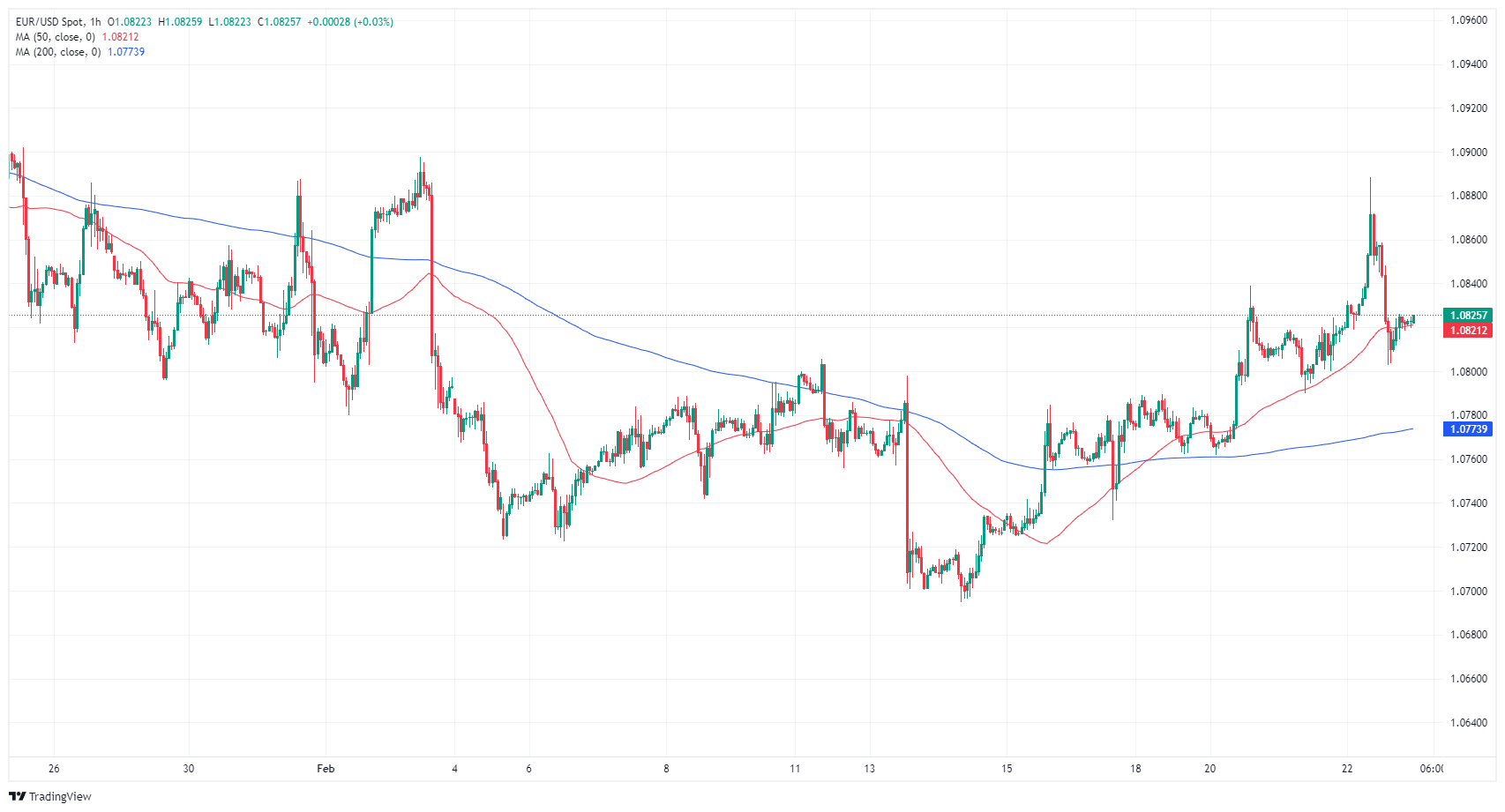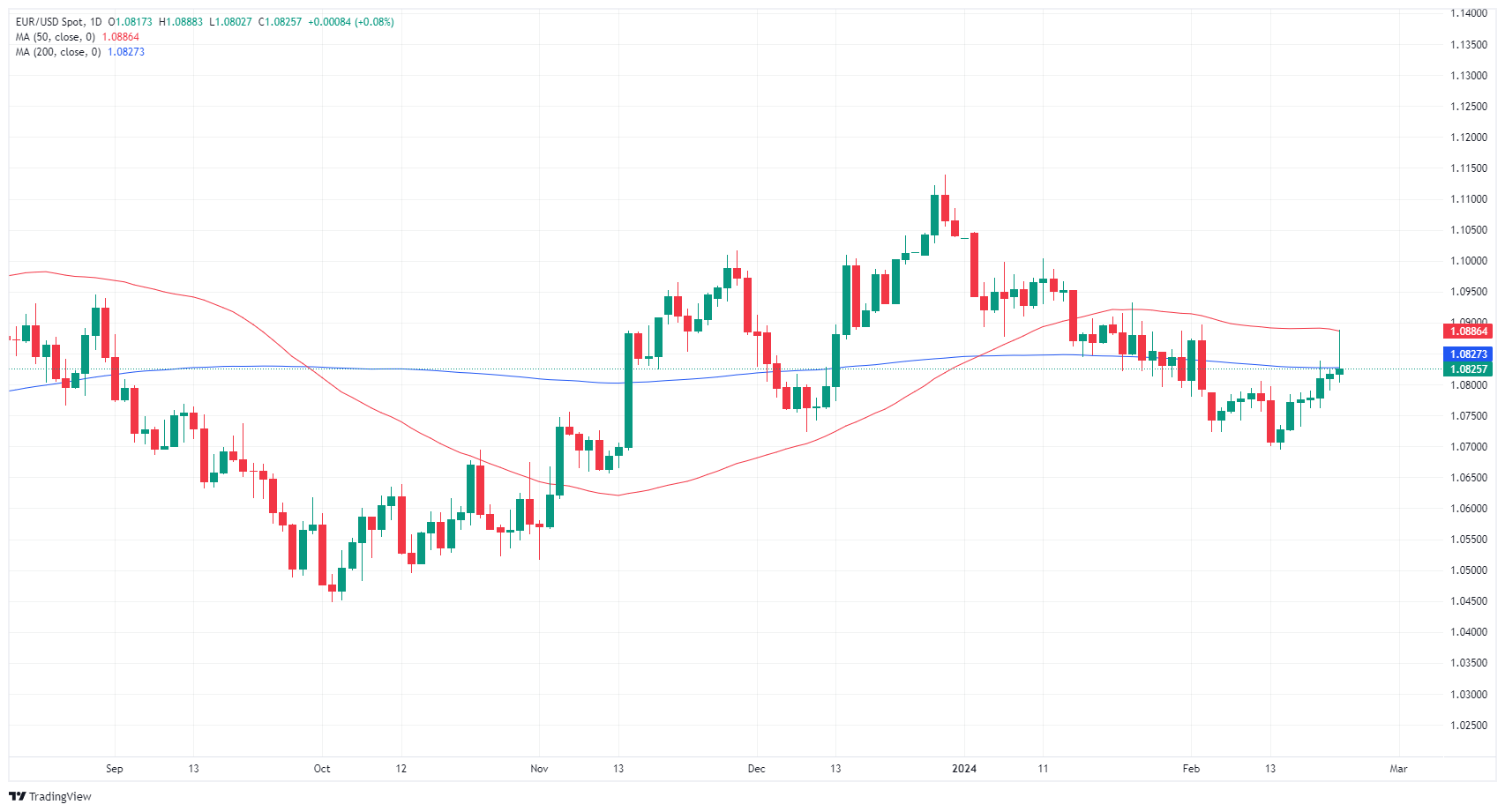- EUR/USD tested fresh highs at 1.0888 before falling back.
- EU and US PMIs came in soft or mixed, giving bulls cause for pause.
- Friday to wrap up the week with German final GDP, Fed MPR.
EUR/USD broke higher on Thursday, testing into its highest bids since the start of February before falling back into the 1.0800 region after European and US Purchasing Managers Index (PMI) figures softened or came in mixed on forecasts. The Pan-European Composite PMI ticked higher, but the Manufacturing component fell back once again, and US PMIs also gave a mixed showing.
Friday brings final German Gross Domestic Product (GDP) figures, and the US Federal Reserve (Fed) will be releasing its Monetary Policy Report to wrap up the trading week. Investors will be gearing up for next week’s US GDP print due next Wednesday, followed by Thursday’s EU Consumer Price Index (CPI) inflation figures alongside US Personal Consumption Expenditure (PCE) numbers.
Daily digest market movers: EUR/USD recedes just as quickly as it rises on PMI hesitation
- Germany’s HCOB Services PMI rose to 48.2 in February, beating the 48.0 forecast and the previous print of 47.7, while the Manufacturing component declined to a four-month low of 42.3 versus the forecast uptick to 46.1 from January’s 45.5.
- The Pan-European HCOB Composite PMI rose to 48.9 against the forecast of 48.5 from 47.9, getting bolstered by the European Services component printing at 50.0, above contractionary territory for the first time in seven months. The Services component was expected to print at 48.8 versus the previous 48.4.
- Europe’s Manufacturing PMI component fell to 46.1 versus the forecast of 47.0, falling away from the previous 46.6.
- On the US side, the S&P Global Services PMI fell to 51.3 against the expected 52.0, pulling back even further away from the previous print of 52.5.
- The Manufacturing component swung upward to 51.5 compared to the forecast for 50.5, climbing over the previous 50.7 and posting its highest figure since October of 2022.
- Read more: US S&P Global Manufacturing PMI improves to 51.5.
- Fed's Jefferson: Cautiously optimistic about inflation progress.
Euro price today
The table below shows the percentage change of Euro (EUR) against listed major currencies today. Euro was the strongest against the Swiss Franc.
| USD | EUR | GBP | CAD | AUD | JPY | NZD | CHF | |
| USD | -0.01% | -0.18% | -0.09% | 0.01% | 0.14% | -0.27% | 0.21% | |
| EUR | 0.02% | -0.17% | -0.10% | 0.03% | 0.14% | -0.25% | 0.23% | |
| GBP | 0.17% | 0.17% | 0.07% | 0.18% | 0.31% | -0.09% | 0.41% | |
| CAD | 0.08% | 0.10% | -0.08% | 0.12% | 0.24% | -0.16% | 0.32% | |
| AUD | -0.01% | -0.01% | -0.18% | -0.10% | 0.13% | -0.27% | 0.23% | |
| JPY | -0.14% | -0.15% | -0.34% | -0.26% | -0.15% | -0.41% | 0.10% | |
| NZD | 0.28% | 0.26% | 0.09% | 0.16% | 0.27% | 0.40% | 0.48% | |
| CHF | -0.23% | -0.24% | -0.42% | -0.34% | -0.23% | -0.09% | -0.51% |
The heat map shows percentage changes of major currencies against each other. The base currency is picked from the left column, while the quote currency is picked from the top row. For example, if you pick the Euro from the left column and move along the horizontal line to the Japanese Yen, the percentage change displayed in the box will represent EUR (base)/JPY (quote).
Technical analysis: EUR/USD hits four-week high before falling back into 1.0800 region
EUR/USD’s bullish push on Thursday has the pair on pace to secure its seventh consecutive bullish close as long as Euro (EUR) bidders keep the pressure up, and the pair is finding intraday technical support from the 200-hour Simple Moving Average (SMA) near 1.0770. The immediate ceiling is parked at the 1.0900 handle with the pair supported from 1.0800.
Thursday’s bull run and subsequent slide has the EUR/USD facing a technical rejection from the 200-day SMA at 1.0827, and it’s a bidders ballgame to lose as the pair stumbles on the low side of recent consolidation between 1.0900 and 1.0850.
EUR/USD hourly chart
EUR/USD daily chart
Euro FAQs
What is the Euro?
The Euro is the currency for the 20 European Union countries that belong to the Eurozone. It is the second most heavily traded currency in the world behind the US Dollar. In 2022, it accounted for 31% of all foreign exchange transactions, with an average daily turnover of over $2.2 trillion a day.
EUR/USD is the most heavily traded currency pair in the world, accounting for an estimated 30% off all transactions, followed by EUR/JPY (4%), EUR/GBP (3%) and EUR/AUD (2%).
What is the ECB and how does it impact the Euro?
The European Central Bank (ECB) in Frankfurt, Germany, is the reserve bank for the Eurozone. The ECB sets interest rates and manages monetary policy.
The ECB’s primary mandate is to maintain price stability, which means either controlling inflation or stimulating growth. Its primary tool is the raising or lowering of interest rates. Relatively high interest rates – or the expectation of higher rates – will usually benefit the Euro and vice versa.
The ECB Governing Council makes monetary policy decisions at meetings held eight times a year. Decisions are made by heads of the Eurozone national banks and six permanent members, including the President of the ECB, Christine Lagarde.
How does inflation data impact the value of the Euro?
Eurozone inflation data, measured by the Harmonized Index of Consumer Prices (HICP), is an important econometric for the Euro. If inflation rises more than expected, especially if above the ECB’s 2% target, it obliges the ECB to raise interest rates to bring it back under control.
Relatively high interest rates compared to its counterparts will usually benefit the Euro, as it makes the region more attractive as a place for global investors to park their money.
How does economic data influence the value of the Euro?
Data releases gauge the health of the economy and can impact on the Euro. Indicators such as GDP, Manufacturing and Services PMIs, employment, and consumer sentiment surveys can all influence the direction of the single currency.
A strong economy is good for the Euro. Not only does it attract more foreign investment but it may encourage the ECB to put up interest rates, which will directly strengthen the Euro. Otherwise, if economic data is weak, the Euro is likely to fall.
Economic data for the four largest economies in the euro area (Germany, France, Italy and Spain) are especially significant, as they account for 75% of the Eurozone’s economy.
How does the Trade Balance impact the Euro?
Another significant data release for the Euro is the Trade Balance. This indicator measures the difference between what a country earns from its exports and what it spends on imports over a given period.
If a country produces highly sought after exports then its currency will gain in value purely from the extra demand created from foreign buyers seeking to purchase these goods. Therefore, a positive net Trade Balance strengthens a currency and vice versa for a negative balance.
Information on these pages contains forward-looking statements that involve risks and uncertainties. Markets and instruments profiled on this page are for informational purposes only and should not in any way come across as a recommendation to buy or sell in these assets. You should do your own thorough research before making any investment decisions. FXStreet does not in any way guarantee that this information is free from mistakes, errors, or material misstatements. It also does not guarantee that this information is of a timely nature. Investing in Open Markets involves a great deal of risk, including the loss of all or a portion of your investment, as well as emotional distress. All risks, losses and costs associated with investing, including total loss of principal, are your responsibility. The views and opinions expressed in this article are those of the authors and do not necessarily reflect the official policy or position of FXStreet nor its advertisers. The author will not be held responsible for information that is found at the end of links posted on this page.
If not otherwise explicitly mentioned in the body of the article, at the time of writing, the author has no position in any stock mentioned in this article and no business relationship with any company mentioned. The author has not received compensation for writing this article, other than from FXStreet.
FXStreet and the author do not provide personalized recommendations. The author makes no representations as to the accuracy, completeness, or suitability of this information. FXStreet and the author will not be liable for any errors, omissions or any losses, injuries or damages arising from this information and its display or use. Errors and omissions excepted.
The author and FXStreet are not registered investment advisors and nothing in this article is intended to be investment advice.
Recommended content
Editors’ Picks

EUR/USD bounces off 1.1300 neighborhood; shows resilience below 23.6% Fibo.
EUR/USD drifts lower for the second straight day amid a further USD recovery from a multi-year low. The technical setup favors bulls and warrants caution before positioning for a deeper corrective fall. A sustained break and acceptance below 1.1300 could pave the way for some meaningful decline.

GBP/USD weakens below 1.3300 as US Dollar rises
GBP/USD extended its losses during Wednesday’s Asian session, trading around 1.3300 after pulling back from a seven-month high of 1.3424 recorded in the previous session. The pair weakened as investor appetite shifted back toward US assets, including the US Dollar, buoyed by a more optimistic tone from US President Donald Trump.

Gold price sticks to intraday losses amid positive risk tone; still holds comfortably above $3,300
Gold price moves away from the all-time peak touched on Tuesday amid receding safe-haven demand. Easing US-China tensions remains supportive of the risk-on impulse and weighs on the XAU/USD pair. The downside for the commodity seems limited as the USD bulls seem reluctant amid Fed rate cut bets.

Dogecoin lead double-digit gains across meme coins, with Shiba Inu, PEPE and BONK skyrocketing to new monthly highs
Top meme coins Dogecoin, Shiba Inu, PEPE and BONK lead the meme coin sector with double-digit gains on Wednesday following the crypto market recovery.

Five fundamentals for the week: Traders confront the trade war, important surveys, key Fed speech Premium
Will the US strike a trade deal with Japan? That would be positive progress. However, recent developments are not that positive, and there's only one certainty: headlines will dominate markets. Fresh US economic data is also of interest.

The Best brokers to trade EUR/USD
SPONSORED Discover the top brokers for trading EUR/USD in 2025. Our list features brokers with competitive spreads, fast execution, and powerful platforms. Whether you're a beginner or an expert, find the right partner to navigate the dynamic Forex market.



